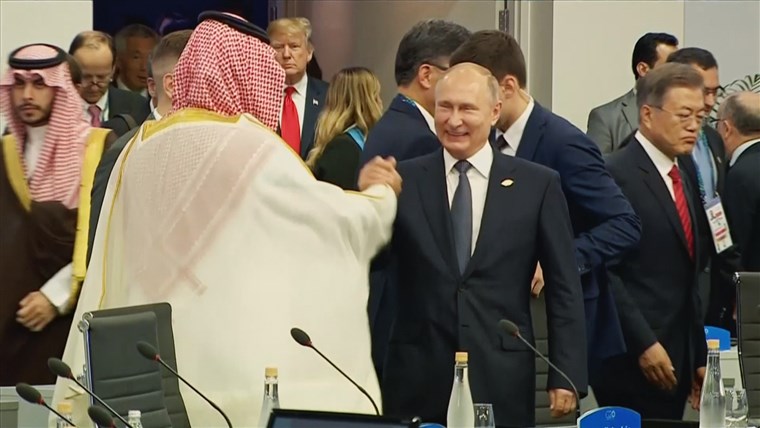The shocks from COVID-19 likely to affect energy and the climate are multiple and unprecedented in scale and scope. Shocks from collapsing prices due to plummeting and then paralyzed demand combined with overproduction: this is the case for oil, but also to a lesser extent for electricity and gas. Other raw materials are also being affected. Shocks to investments, because oil as well as electricity companies are experiencing dramatic falls in earnings while waiting for the peak of the pandemic to pass. They are cutting spending and revising or postponing projects. Jobs and smaller company survival are under threat.
Geopolitical shocks with the March collapse of the Organization of the Petroleum Exporting Countries (OPEC+) alliance, tensions between Russia and Saudi Arabia on the one hand, and between United States and Saudi Arabia on the other hand. Both Russia and Saudi Arabia can withstand a year of low prices while still suffering pains, yet have an interest in halting the rise in US crude exports. These tensions come as Mohammed bin Salman seeks to make his succession to the throne safe, as Donald Trump wants to be re-elected and as Vladimir Putin adopts a strong posture and can now lead Russia… until 2036. The economic, political and social stability of numerous poorly-diversified oil, gas and metals producer countries is under threat.
Shocks to public policies and climate governance: while greenhouse gas emissions (GHG) are falling, they may well rise with an economic upturn, whereas cuts of -8% per year to 2030 are required to be on a global warming path of +1.5°C. In the European Union, the Green Deal agenda has been disrupted (the Climate Law and 2030 objectives notably). Some want to bury it in the name of realism. Carbon prices in the Emission Trading Scheme (ETS) are plunging, making pollution cheaper and destroying investment signals. Support capabilities for low carbon technologies will be more constrained. Across the world, support for other low carbon technologies may suffer – though ultra-competitive solar power may be spared. The COP26 climate conference is postponed, as will be the COP15 on biodiversity. Faced with such shocks, which are still unfolding, some major tendencies and areas of re-balancing can be outlined.
1. Oil and gas: demand peak, diversification by the “majors”, and a deflating LNG bubble
Oil prices will eventually go up when demand recovers, but this will be progressive as the global recovery will be uneven and as large stocks will have to be absorbed. Market re-balancing could be facilitated if OPEC+ revives sooner or later, but an ultra deep and concerted cut of at least 10 mb/d seems hard to agree and implement. Saudi Arabia not pushing +2.5 mb/d on the market and a concerted cut of 5 mb/d as from summer looks more realistic, especially since reduced drilling in the US shale will have brought production down. However, many State producers are in such distress that they will try to produce as much as possible, especially if prices rise. Meanwhile, producers, including the US, can talk the price up and help to avoid it collapsing once global storage capacity is filled.
Rising oil prices may not restore upstream investment though to the pre-crisis level and oil output tensions are expected to follow, helping the price recovery. The demand peak for oil could henceforth take place between 2025-2028, with less growth in petrochemicals and a rapid stabilization of demand in transport due to higher prices. States will strengthen taxation of fuels and clean mobility will roll out. It will take at least three years for the airline industry to recover, and the cost of air transport should rise, despite lower kerosene prices, due to carbon taxation (in the EU) and the restructuring of the sector. The recovery will not be helped much by low prices that will only be partially passed on to the pump.
A turning point could take place, with a scenario over the medium term combining a global expansion of low carbon technologies (solar notably), an oil demand peak, with a price of $60-$70 per barrel which does not trigger higher investment and additional supplies. But even if prices rise, environmental and financial constraints along with risks will reduce the attractiveness of the oil sector. The majors will benefit from concentration in the sector. They are likely to start or accelerate their diversification and cut their carbon footprint, following a combination of weaker profitability in upstream projects and tougher Environmental, Social and Governance (ESG) standards, difficulties in managing tax burdens from hard-pressed rentier States, and increased security risks.
2. Geopolitics: weaker rentier States and populist regimes, climate governance in tatters
American ambitions for supremacy in oil and gas exports are on hold. Populists like Trump, Bolsonaro and Obrador are facing rising problems. The reputations of Russia and Saudi Arabia have been tarnished among numerous rentier States, whose economic and social stability is being eroded. These rentier States face three scenarios: accelerate their diversification by attracting private and foreign capital, which implies a radical shift in their governance; attempt to hold on, by means of enhanced repression, while waiting for prices to rise; or be destabilized and collapse, as the price recovery can take too long for them to cope, especially if they failed to reform since 2015. The International Monetary Fund (IMF) will have a historic opportunity to provide some of them with liquidity, in return for much needed governance reforms.
While the world breathes again, there is a risk of collapse in climate governance. Trump is already showing that recovery measures can be used to weaken environmental regulation, adding irresponsibility to injury. Yet with the postponement of the COP26 until 2021, the EU will be able to put forward its Climate Law, and will have more time to develop a global benchmark for a sustainable recovery plan and put pressure on recalcitrant members. With cheap oil and gas, all States, including the EU, have a historic opportunity to redirect fossil fuel subsidies towards low carbon technologies such as super competitive solar power. China may choose not to raise its climate ambitions, but to take advantage of crises to strengthen its global influence and continue exporting its polluting technologies. If responsibility for spreading the virus is taken into account, this would constitute an inevitable rupture. In contrast, if China opts for climate cooperation, the credibility of its choice at home and abroad must be ensured.
3. A European Green and Solidarity Pact to stimulate recovery
Struggles over economic recovery will follow those concerning COVID-19 and social safeguards. The EU is likely to enter these struggles divided, as illustrated by the refusal of the Netherlands, Germany, Finland and Austria especially to agree to “coronabonds”. A European roadmap is being prepared at the request of the European Council, which calls for a sustainable recovery, without naming the Green Deal. The recovery would be helped greatly by: increasing support for investment in energy effectiveness and efficiency, clean mobility, clean hydrogen, biomethane, nuclear, solar and wind power, as well as smart digital systems and networks where necessary. Efforts must absolutely benefit European industries and jobs. Instead of postponing a decision on strengthening the goals for 2030, setting a clear course by September latest is essential, a minima by -50% greenhouse gas (GHG) reduction, with an upward revision clause by 2025. One thing is clear: the ETS is unable to achieve sufficient decarbonization and electricity markets will be even less capable of triggering the necessary investment. With Europe’s taxonomy established, it is time to launch Green Deal Bonds, and to vote an exceptional budget for 2021, and providing the EU with more budgetary resources for the period from 2022 to 2027.
It is vital to align measures promoting social justice and climate preservation to avoid rising populism and popular rejection, which undermine democracy and confidence in the EU. A carefully-targeted policy of social redistribution, taxing goods and activities which are not essential and polluting, can deliver. Otherwise social and environmental protests will come together in a large movement, which could become extreme and affect States and companies. The cost of mobilizing solidarity over the next six months to support the countries hardest hit by the pandemic, and especially Italy and Spain, will be insignificant compared to the fallout from their durable instability and the unraveling of the EU. Meanwhile, towns and territories need new means and instruments to fight against environmental degradation and for sanitary resilience – that is why the Green Deal must be enlarged into a European Green and Solidarity Pact.
Lastly, this crisis could lead to geopolitical upheavals in Europe’s neighborhood, going as far as sub-Saharan Africa. This is where efforts need to be made to improve governance and investment frameworks for low carbon technologies, adaptation to climate change and for sustainable cities.
‘Energy, Climate and the Covid-19 Shocks: Double or Quits’ – Editorial by Marc-Antoine Eyl-Mazzega – Institut français des relations internationales / IFRI.




